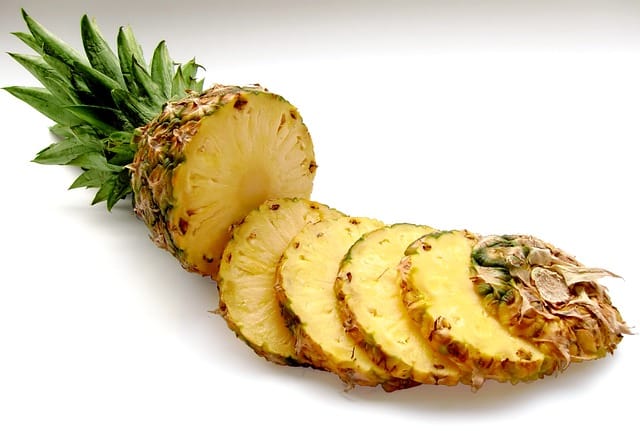How to grow Pineapples
Welcome to the ultimate guide on how to grow delicious pineapples in your own backyard! Pineapples are tropical fruits known for their sweet and tangy flavor

In this article:
- Introduction
- Choosing the Right Variety
- Climate and Soil Requirements
- Growing Pineapples from Seeds
- Propagating Pineapples through Crown Cuttings
- Preparing the Planting Site
- Planting Pineapples
- Watering and Fertilizing
- Providing Support and Protection
- Managing Pests and Diseases
- Pruning and Thinning
- Harvesting Pineapples
- Storing and Preserving Pineapples
- Common Pineapple Growing Mistakes
- Frequently Asked Questions (FAQs)
- Conclusion
Introduction
Welcome to the ultimate guide on how to grow delicious pineapples in your own backyard! Pineapples are tropical fruits known for their sweet and tangy flavor. With the right knowledge and techniques, you can successfully grow these fruits and enjoy the taste of the tropics at home.
Choosing the Right Variety
Before you start growing pineapples, it's important to choose the right variety. Some popular varieties include Smooth Cayenne, Queen, and Abacaxi. Research each variety's characteristics, growth habits, and taste to determine which one best suits your preferences and growing conditions.
Climate and Soil Requirements
Pineapples thrive in warm tropical and subtropical climates. They require temperatures between 65°F and 95°F (18°C - 35°C) to grow successfully. The soil should be well-draining with a pH level between 4.5 and 6.5. If your soil is acidic or alkaline, you may need to amend it before planting.
Growing Pineapples from Seeds
While growing pineapples from seeds is possible, it is not commonly done as it takes a longer time to bear fruit. However, if you are interested in a fun experiment, you can try growing pineapples from seeds. Simply clean the seeds, plant them in a seed tray or pot, and provide them with warmth, sunlight, and regular watering until they germinate.
Propagating Pineapples through Crown Cuttings
The most common method of growing pineapples is through crown cuttings. To propagate a pineapple plant from a crown cutting, select a healthy pineapple with a firm, green crown. Remove the crown by twisting it gently or cutting it off with a sharp knife. Leave the crown to dry for a couple of days before planting it.
Preparing the Planting Site
Prepare the planting site by clearing away any weeds or debris. Make sure the area receives full sun exposure. If necessary, you can improve the soil's drainage by adding organic matter such as compost or well-rotted manure. Pineapples prefer well-aerated soil, so loosen it to a depth of at least 8 inches.
Planting Pineapples
When planting pineapples, dig a hole slightly larger than the crown's size and place the crown into the hole, ensuring that the base is level with the soil surface. Gently firm the soil around the crown, making sure it is secure. Leave some space between plants, as pineapples can grow quite large.
Watering and Fertilizing
Pineapples require regular watering, especially during dry periods. However, it's important not to overwater them, as excessive moisture can lead to root rot. Water the plants deeply once or twice a week, allowing the soil to dry out partially before watering again. Additionally, apply a balanced fertilizer every 6-8 weeks to promote healthy growth.
Providing Support and Protection
As pineapples grow, they may require support to prevent them from toppling over. You can use stakes or a bamboo frame to provide support. Additionally, protect your pineapples from strong winds by planting them near a fence or wall. Consider using organic mulch around the base of the plants to conserve moisture and suppress weed growth.
Managing Pests and Diseases
Pineapples are relatively resistant to pests and diseases. However, they can occasionally face issues such as mealybugs, aphids, or root rot. Monitor your plants regularly and take immediate action if you notice any signs of pests or diseases. In some cases, natural remedies like neem oil or insecticidal soap can be used to control infestations.
Pruning and Thinning
Pruning and thinning pineapples are essential for maintaining plant vigor and fruit production. Remove any dead or yellowing leaves from the plant to maintain its overall health. Additionally, thin out excess suckers to prevent overcrowding and allow the main plant to receive sufficient resources for fruit development.
Harvesting Pineapples
Pineapples are typically ready for harvest 18-24 months after planting, depending on the variety. Look for a change in color, firmness, and aroma to determine ripeness. Once mature, cut the fruit off the plant using a sharp knife. Ensure you leave a small portion of the stalk attached to the fruit.
Storing and Preserving Pineapples
Freshly harvested pineapples can be stored at room temperature for a short period, but they are best consumed as soon as possible. To extend their shelf life, you can store them in the refrigerator or freeze them for future use. Canned or dehydrated pineapples are great options for long-term storage.
Common Pineapple Growing Mistakes
Despite their relative ease of cultivation, there are a few common mistakes that novice gardeners make when growing pineapples. Some of these include overwatering, planting pineapples too closely together, neglecting proper drainage, and not providing enough support. Be mindful of these mistakes to maximize your chances of success.
Frequently Asked Questions (FAQs)
Q: Can I grow pineapples indoors?
A: Yes, you can grow pineapples indoors if you provide them with sufficient sunlight or artificial grow lights.
Q: How long does it take for a pineapple plant to bear fruit?
A: It typically takes 18-24 months for a pineapple plant to bear fruit, although it can vary depending on growing conditions.
Conclusion
Now that you have learned the essential steps for growing pineapples, you are ready to embark on your pineapple-growing journey. With patience, proper care, and the right growing conditions, you can enjoy the satisfaction of growing your own delicious pineapples right at home. Happy gardening!
